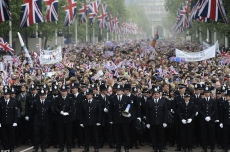
In the previous two articles we looked at how, interestingly, just by being part of a crowd, our whole behaviour can change. This surprising finding may be hard to come to terms with, since most people do not like to think about the possibility of themselves doing ‘bad’ things and believe that these are only carried out by inherently ‘bad’ people. In reality however, our behaviour can be thought of as being determined by our biology and outside forces from all around us, while our so called ‘free will’ is non-existent. This is an assumption that makes no sense to take heed to when going about everyday life, but it may be important to consider in situations where people are looking to place the blame. This is important in Criminology because from this standpoint the whole criminal justice system we use today is faulted. Perhaps criminals should not be punished based on how bad their crime was, as how they acted may have been determined by factors beyond their control, but based on how we can best stop them from re-offending. In fact, it may be best for criminologists and psychologists alike to consider how we can control the behaviour of crowds and prevent problems arising from their presence in the first place.
The police, in situations where crowds are formed today can be relatively ineffective at dealing with the problem, often making matters worse by increasing the intensity of the situation at hand when they step in. This is perhaps because they follow old and incorrect assumptions about the nature of crowds. They may wrongly believe that crowds are unreasonable and follow no pattern in the way they behave, when in fact there have been shown to be codes of practice in most crowd situations, however invisible they may seem. Sometimes this wrong perception makes behaviour seem more threatening than it is actually intended to be, leading police over-reaction, which then leads to over-reaction on the part of the crowd. This is when danger becomes evident. To stop this from happening, perhaps we need to improve police ability to identify the nature of crowds.
This can be done by looking at prior meetings of the crowd, for example, in the case of protest rallies, looking at the outcomes of previous ones run by the same people will give you a prediction of how this one will result. Often however, dissent from the crowd is caused by just a few trouble-makers which insight antisocial behaviour from the rest of the crowd. Perhaps then we should focus on individuals within the crowd to predict whether there will be trouble or not.
Since deindividuation plays an important part in determining crowd behaviour, it may be useful to make it evident to members of the crowd that they can each be identified, perhaps by adding security guards or CCTV cameras. This may make people more wary about the way that they behave and reduce their susceptibility to suggestion from other members of the crowd.
Waddington did research on two public rallies of miners in 1984. One resulted in violence, while one remained peaceful. Data was collected on each to search for other differences that could have resulted in this differentiation. They found that the two were very similar, except that the second had occurred after discussions with the police, making certain arrangements that may have led to a more peaceful result. This led Waddington to suggest some courses of action for helping to control crowds. It was suggested that they should be self-policed by members of the protest group themselves, the protesters should organise the event alongside the police, the police should keep a low profile and use minimal force as this could suggest that they were expecting a fight, the people in charge should be careful not to cause antagonism with their actions, and the police must make clear to the crowd that they are accountable for their own actions.
The one problem with these suggestions is that they do not take into account that many crowds gather spontaneously, and so these measures cannot be put in place. Often, in these cases, people are very easily suggestible by others since they do not know how to react. Because of this, it is more likely that aggressive behaviour will occur in these, less predictable situations and so greater police intervention may be necessary. Hopefully further research into this area will provide greater understanding so that in the future we can finally put a stop to riot and mob based disasters for good.
Image from: http://i.dailymail.co.uk/i/pix/2011/04/29/article-1381820-0BD457AF00000578-81_964x639.jpg

0 Comment:
Be the first one to comment on this article.